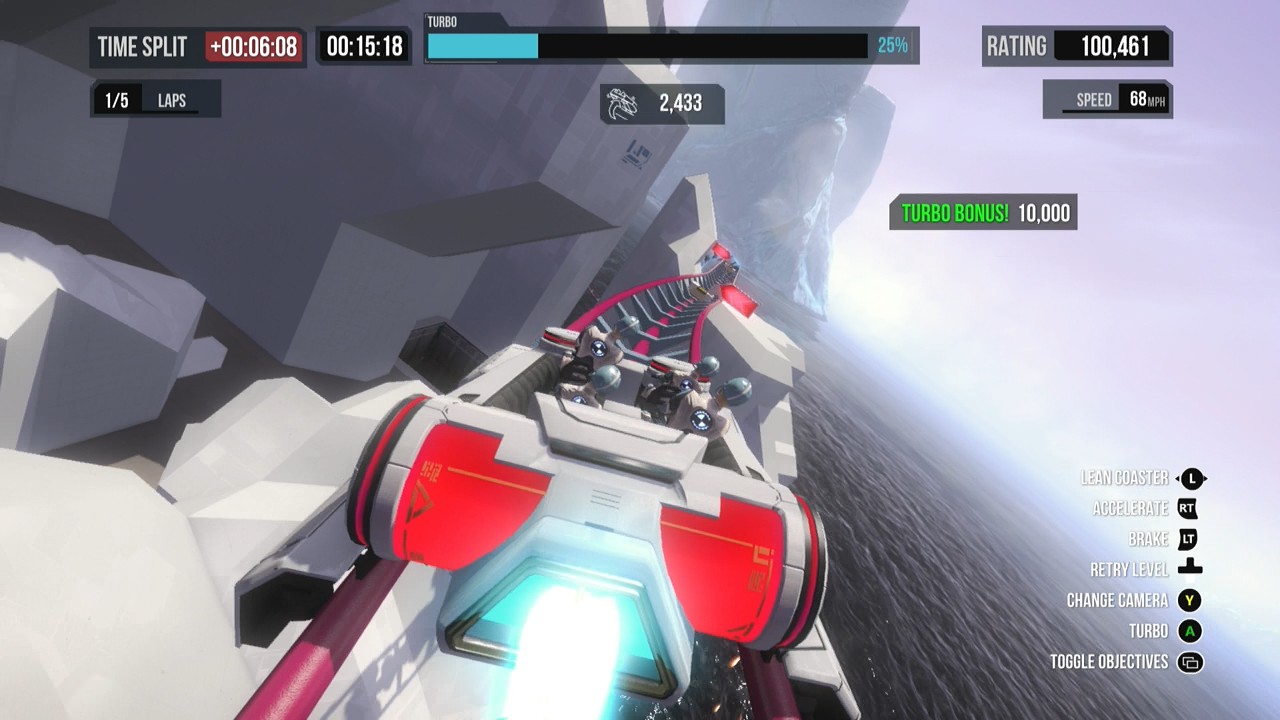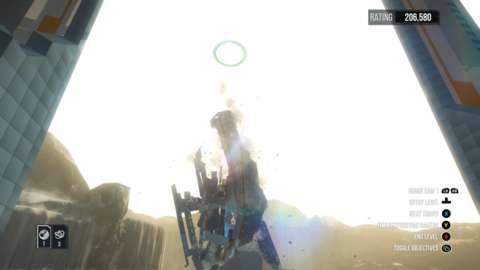As fun as it is, there's something rather...disturbing...about Screamride. A game about racing rollercoaster cars down rails at tremendous speeds and smashing them into concrete skyscrapers isn't to be taken seriously, of course, and I'm not terribly concerned about the riders, who seem beyond thrilled for the chance to sacrifice their well-being for the chance to fling themselves into solid objects. My worry lies with the pedestrians walking around out there. There are promenades to stroll on among the office buildings and laboratories. What right-minded individual would think to hang out there--or to work there?
Well. This isn't the kind of thing you're supposed to be thinking when you play Screamride, which sets itself apart from the developer's own Rollercoaster Tycoon series in this regard. In the RCT series, a crash was always a tragedy; Screamride's thrill-seekers hoot and holler on their way towards collisions like the Duke boys sliding across the hood of the General Lee, and the rocktronica soundtrack doesn't miss a beat, even when the riders' ragdoll bodies thump against asphalt. They must enjoy it. So do I, actually, though your enjoyment depends on your willingness to cast aside memories of Rollercoaster Tycoon and its freedoms in favor of Screamride's hyper-happy attitude and unique mix of construction and destruction.

Add racing to that mix, too, if you want a fuller picture. Screamride is split into four discrete chunks: racing, demolition, engineering, and sandbox creation, locking creation tools behind gates that can only be opened by participating in career events. That's not the worst thing in the world--Little Big Planet manages to make the idea work, after all--but if coaster creation is your primary draw, busywork is mandatory. There are other limits that also stifle creative minds bursting with ideas, but forget about them for a moment. Instead, picture a roller coaster that gives its riders a modicum of control over speed and balance--coaster cars with brakes and accelerators, and with limited boosting capabilities, that let you lean into curves so you don't go flying from the tracks as you whip around corners.
Experiencing a coaster this way is called screamriding, and it closely resembles traditional racing, apart from the obvious limitation of being glued to the track, with the exception of jumps, or in circumstances when the race purposefully ends with a coaster train launching from the track and into a high-rise. You are an active participant, earning boost by pressing a button just as you near the end of a blue stretch of track, and using an analog stick to nudge the car left or right, either to keep the car on the track, or to navigate the twists the game throws in, such as monorails that require you to lean on two wheels. Of course, most of the twists are in the coaster design themselves. No real-life coaster would risk such barf-inducing curlicues, but in the Screamride fantasy, why not throw caution to the wind? The rider-view camera angles might inspire some waves of nausea for you, but I never felt like upchucking. Then again, I seem to be immune from coaster sickness in real life, too.
Your enjoyment depends on your willingness to cast aside memories of Rollercoaster Tycoon and its freedoms in favor of Screamride's aggressive xtreme attitude and unique mix of construction and destruction.
Real life coasters rarely allow you to reach speeds of 150 miles per hour, unless you're a regular at Ferrari World in Abu Dhabi. Early on, when navigation isn't so tricky, it's easy to enjoy the thrills; as the campaign progresses, you're more concerned with spotting where blue tracks ends so you can earn a spot of boost, and with avoiding spills that could cost you time. At advanced stages, Screamride isn't about the joys of riding roller coasters: It's about gaining as many points as you can and showing off your skills on the game's online leaderboards. The game's insistence on turning everything into a competition is its defining negative feature, actually. "Sorry if you want to just ride the coaster and enjoy it!" says Screamride. "Roller coasters aren't fun enough on their own." Screamriding comes with its own kind of thrills, at least; finishing the Sky-Scraping Serpent challenge without a derailment rewards you not just with points, but by allowing you to sigh with relief after several minutes of white-knuckle track navigation.
Screamride's biggest gameplay triumph is only tangentially related to coasters. The game is big on destruction. It wants you to see colossal buildings collapse into voxelized heaps, and even showcases a few debacles outside of demolition levels. (You can even fly your car into towers should you launch from the track during a race.) Being a demolition expert is the game's strongest allure. On a fundamental level, demolition challenges are akin to a 3D version of Angry Birds: You launch a cabin from a rotating arm into arrangements of structures in the hope of causing a cavalcade of destruction and gaining points for it. (2007's Pain for the PlayStation 3 also springs to mind as an apt comparison.) Explosive barrels are tucked away in strategic places, and spires are placed to maximize damage if you bump them in just the right way.

Demolition is based on physics, so even a seemingly perfect launch may not have the effect you desired. Luckily, Screamride avoids Angry Birds' aggravations, focusing more on the demolition than on unreasonable challenges. Later levels add all sorts of accoutrements to the mix: cabins that divide or bounce, trampolines and magnets that extend your cabin's usefulness, and so forth. Other levels launch coaster cars off of a track and let you steer them directly into structures. Whatever the specific wrecking ball you use, razing a level is wholly satisfying. Monoliths topple onto other monoliths like a set of massive dominoes, and firing a cabin into the spindly legs of a colossal robot causes it to collapse upon itself in a glorious implosion of rubble. You can always restart the level with the press of a button should you miss your target; doing so causes demolished structures to be rebuilt as you watch, a process that might have been almost as amusing as the demolition if it didn't cause the frame rate to hit rock bottom. (Generally, the frame rate is not Screamride's strong suit.)
You get your build on in Screamride's engineering challenges. The sandbox aside, these levels best hark to the spirit of Frontier's previous creations, plopping a coaster down on some terrain, and asking you to complete it using a specific set of standards. "Complete the coaster with a minimum drop height of 100 meters, a minimum travel length of 950 meters, a top speed of 93 mph minimum, and using at least three special pieces" is one such goal, though others are much simpler ("Launch a rider"). There are some engineering control quirks to contend with, mostly to do with navigating between disconnected tracks, but the interface is otherwise commendable, and it's easy to test your coaster as you progress, and then return to construction, where you can add and twist tracks to your heart's content.

The interface's usability is at its most apparent when you delve into Screamride's sandbox, which is overflowing with ways to build coasters and environments, whether you intend for those environments to provide atmosphere, or whether you intend to annihilate them. Make your own structures using cubes of concrete, glass, iron, and stone. Craft the island that your challenge rests upon with tiles of grass and metal. Delve into blueprints, where you can find pre-fashioned constructs that help automate the parts you aren't interested and focus on the parts you care about. Screamride asks a lot of a controller, given all the baubles and doodads, but clear tooltips make the process as simple as you could ask for.
There are complications that arise: all of this creation is in the service of a screamriding, demolition, or engineering challenge, so if you want to share your accomplishment, you must adjust vital parameters. That means setting goals, establishing any limits on coaster parts like loops and corkscrews, bonus challenges, and so forth. If you apply yourself, however, the results can be marvelous. As I write this, Screamride has not been released to the public, but press members and Frontier's developers have crafted some excellent stuff, like my favorite of the screamriding challenges, The Vaporizer, which flies along at speeds surpassing 170 miles per hour, and offers no hope of figuring which way is up and which is down until the challenge had ended. Thanks, SirTokeAlot85! Too bad I can't see how I fared against other racers on your level--or on any user-created levels.

The game is big on destruction. It wants you to see colossal buildings collapse into voxelized heaps.
The sandbox's downfall is not in the breadth of its toolset, but in the limitations on how you use it. Screamride suffers from a pressing need to give everything you do the same structure as its career challenges. You cannot simply build a coaster, ride it, and share it for others to do the same--not directly. Well, you can build an engineering challenge and ride your creation by testing it during and after construction, and then remove a couple of pieces of track and create a lame challenge out of it for others to complete and test. Or, you can save your coaster as a blueprint, which other players can use in their own level, which requires building a level, placing your coaster, and testing it. Or, others can download your challenge and then edit and test the coaster. But these are convoluted ways of circumventing Screamride's "Roller coasters aren't fun enough on their own!" outlook. It's frustrating to have so many tools, and so few ways of putting them to use, like an overwhelming pile of Legos that you can only use for making a boat, a car, or a house. Future downloadable content allowing for straightforward sharing, riding (not screamriding), and viewing coasters in action would be as surprising as a pile of vomit at Busch Gardens Tampa's Montu exit.
I don't wish to further belabor the issue of "what Screamride doesn't do," however, because "what Screamride does do" is a more interesting subject. It turns roller coaster riding into a self-destructive blood sport in which you demolish buildings and ruin little computer people's lives for the inherent joy of it. Building up and tearing down is an age-old pleasure, and seeing sky-high structures fall like dominoes with a flick of a stick is Screamride's primary delight. I sometimes think of all those digital men and women that went plummeting to their dooms, but at least they died doing what they loved.